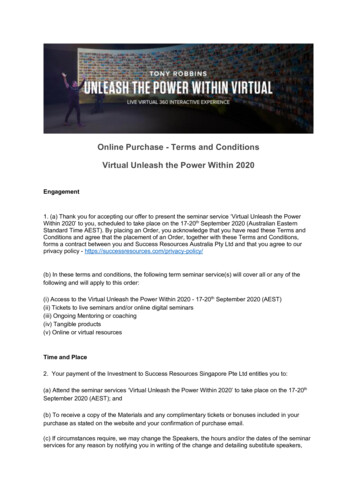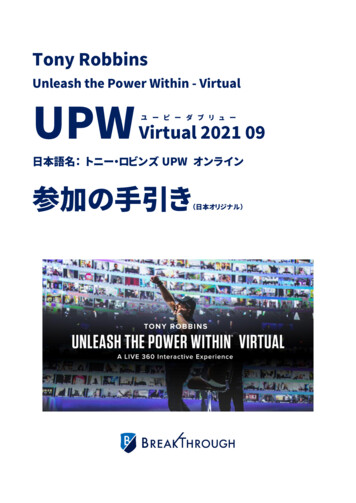
Transcription
Unleash the powerof Agile withinmarketing1
THE DIGITAL SHIFTCALLS FOR AGILEMAKING SENSE OFAGILE MARKETINGDigitalization and the emergence of new digital technologies areconstantly transforming customer habits and preferences in termsof drivers for customer value. Due to customers’ shifting behavior,companies are facing an increasing need to fundamentally changehow they operate their business in order to secure customer valueand to stay competitive.Transforming marketing functions today is not solely aboutchanging which marketing activities that are executed, but ratherhow the marketing activities are executed. Capgemini Invent seesagile marketing as the application of agile methodologies in themarketing domain, which is often characterized by dividingmarketing activities into different phases (‘sprints’) while keepingan iterative project approach. Three key activities included in anagile marketing approach are:In the marketing domain, executives are now faced with thequestion of how to transform their traditional marketingorganization in order to increase the relevance of their offering.There is an underlying fear of the emerging competition fromdigital leaders who are more agile in their operations and hencebetter equipped for winning customers in the digital age.Digital transformation is on the agenda for most companies acrossmany domains. Nevertheless, to fully embrace the digital era ofmarketing, organizations need to unleash the power of agile withinmarketing and start using an agile approach in e.g. digital saleschannels, digital marketing and digital product development. Thepurpose of agile ways of working is to improve companies’performance through an increased customer centricity, faster timeto market of created initiatives and an increased efficiency withinthe organization. Use of data and analytics to continuously evaluate andadopt marketing activities based on customers’ needs Run new ideas each week based on improvement insightsfrom previous sprints Develop and test new data driven concepts with a fastpaceAgile marketing includes working agile across the entire marketingrelevant domains including e.g. product and service development,customer propositions, customer acquisition, customer retentionand customer loyalty.CompanyMarketingBrand &MarketCommunicationInnovation& l SalesMarketingExecutionAgile MarketingBusiness developmentInsights and dataCustomer supportFigure 1: Illustrative example of working agile across all marketing relevant domains2
WHY AGILEMARKETINGAgile marketing is turning into a popular buzzword, andimplementation projects of agile methodologies are initiatedacross many sectors. Capgemini Invent supports companies inintroducing and applying aforementioned agile methodologies intheir business operating model, including the marketing and theproduct offering domain.Generally, there are two well-known benefits of changing currentways of working to agile ways of working: an improvedunderstanding of customer needs (enhanced customer centricity)as well as an ability to move faster into the market with variousinitiatives i.e. campaigns, new collaborations and productdevelopment initiatives. Applied and executed correctly, an agileapproach in the marketing domain will increase efficiency leading toa better return of investment for the marketing spend.FASTER TIME TO MARKET: Development in the market and userpreferences are moving so fast that turnaround time needs tomatch the speed of the emerging competition from companiesrecognized as digital leaders. Included in the agile method is asprint and iterative project approach which enables an earlylaunch of a product which then, based on data driven insights, canbe iterated and improved over time.EFFICIENCY GAINS: Shifting to agile marketing puts the valuederived from different marketing activities in the center due tocontinuous testing with users, adjustments and optimization everyday, regardless of whether it is a product development project orexecution of a digital marketing campaign.ENHANCED CUSTOMER CENTRICITY: Precision is needed in orderto meet the customers’ needs in products, offerings and marketcommunication. Moreover, the ability to adapt to customers everchanging preferences needs to be incorporated into organizations’ways of working. Agile marketing methods provide better supportby applying user centric, value driven and iterative approaches.Areas Of ApplicationMarketing Marketing communication Brand awareness Brand loyaltyAgilemarketingAchieved BenefitsEnhanced customercentricityAn ability to adjust theoffering to customerpreferencesOffering & ProductsFaster time to market Business and product development Sales & CRMFast response time tochanges in customers’needs and preferencesCustomer JourneysEfficiency gains Efficient and personalized customerjourneys Easily adapt to changing customerpreferencesTesting with users,adjusting & optimizingcontinuouslyFigure 2: Illustrative example of the benefits of incorporating agile marketing in the organization3
AGILE MARKETINGIN REALITYTheoretically, implementing an agile approach across themarketing relevant domain seems to be the way to reducecustomer churn and secure added customer value. In order to fullyexplore the potential benefits of agile marketing, CapgeminiInvent presents a real use case where Capgemini Invent supportedan energy retailer to successfully implement agile methods in theircampaign management for new product and service offerdevelopment.Establishing insight driven iterativeways of workingEach squad was assigned to drive a specific marketing campaignarea. The purpose for that set-up was to make each squad expertsin their respective areas to enable their own continuousimprovement. After designing and scoping a draft for a marketingcampaign, the campaign was launched in the first project sprint.Designing the canvas for an agilemarketing organizationAfter launching the first sprint, continuous evaluation of themarket response of the marketing campaign took place i.e. followup on KPIs for digital channels used and follow-up KPIs on targetedcustomer segments.In order to secure a suitable working climate for agile ways ofworking, the first step was to establish new smaller crossfunctional teams (‘squads’) within the marketing function. Thesquads consisted of members from different parts of theorganization e.g. digital sales and production. Establishing clearboundaries including a set budget and clear KPIs, the squads couldwork autonomously.Gathering insights from the first sprint could then be used asconcrete improvements for the marketing campaign launched inthe second sprint.Moving into an agile approach quicklyleads to tangible resultsIn parallel to setting up the teams, an internal review of currentprocesses was conducted in order to centralize the knowledgewithin the team and to work efficiently during the sprints.By changing the current ways of working to agile methods, insightsfrom real time exposure to customers could be used in order torefine current campaigns. This resulted in increased conversionrates and a better understanding of the drivers for customerretention. Furthermore, by starting the agile transformation in asmaller scale, insights on how to expand the agile ways of workinginto other operative marketing, and other, departments werefound.To secure a sufficient knowledge base and the right workingenvironment for continuous learning within the team, the squadmembers were attributed following roles: Campaign owner,Campaign manager (agile coach), Offering responsible, Channelexecutor, Media buyer, UX and Creative designer and an Analyst fortargeted segments.Agile Marketing & SalesMarketingSalesINCREASED CONVERSION RATESClear KPIs, budget and autonomous teams withindefined boundariesINCREASED REVENUE (NEW ACQUISITION, UPSELLON EXISTINGBASE)REDUCED ACQUISITION COSTSDedicated to an area e.g. customer acquisition,upsell/cross-sell, customer retentionTeam4Campaign ownerCampaignmanagerOffering responsibleChannel executorOwns the commercial roadmap andaligns the campaign plan with theoverall marketing & sales strategyManages the group andensures that the structure of theagile process is being followedCoordinates the work withproduct development &salesExecutes on non-digital channelstrategy and roll outMedia buyerUX & Creative designerAnalystManages the relationship &collaborating withmedia agenciesResponsible for visuals anddesignCompiles insights which work as inputbefore, after and during the sprintsFigure 3: Illustrative example of how to incorporate agile methodologies in the marketing and sales domain
TRANSFORMING INTO ANAGILE MARKETINGORGANIZATIONWhile it may be tempting to move into agile ways of workingquickly, experience shows that such a transformation should bemanaged carefully while maintaining the ambition to move fast.This is what we call a controlled agile approach.There are five key steps when moving into agile marketing:1) Set a vision from the top management and have a long-termroadmap and vision of the desired end state2) Identify and select core areas where agile methodsnaturally create value3) Start small with pilots, learn, adapt and then quickly scale4) Manage the transformation in an agile way withmanagement actively working to remove the backlog ofrequired decisions and roadblocks5) When the organization is mature and have developed anefficient way of working, it is important to start to expandinto new operating areas i.e. product-and servicedevelopmentThe number one critical factor to succeed is top managementownership of an agile vision with customer centricity at heart anda willingness to move there quickly.1Visionfrom top anda long-termroadmap2Core areaswhere agilemethods naturallycreate value3AgileMarketingPilotlearn, adapt andrapidly scale4Managein an agile way,removingroadblocks5ExpandIntonew areas,products andservicesFigure 6: Steps of moving into an agile marketing organization5
AGILEMARKETINGREQUIRES COMMITMENTTransforming the traditional ways of working in marketingactivities to a more agile approach is a complex process.Leadership commitment including action plans on theorganizational changes and an effective resource management,governance and leadership are key to succeed with an agiletransformation.GOVERNANCE ADJUSTMENTS: Planning, financial governance anddecision making processes will be impacted by the transformationfrom traditional marketing to agile marketing. The demand ongovernance changes will start with the alterations in theorganizational blueprint and then adjust as pilots and lessonslearned are incorporated in the transformation journey.ORGANIZATIONAL CHANGE: The transformation to an agileorganization should be executed in an agile way through pilots. Inparallel to the piloting, management needs to define the blueprintfor scaling the agile marketing organization and operating modelaccording to insights obtained from the first pilots. The new andupdated operating model must cater for and allow day-to-dayautonomy in cross-functional teams where decision power isdelegated to the Product Owner .LEADERSHIP: Leadership aspects needs to be adjusted whentransforming the organization to work in agile marketing teams.The new type of leadership will include a more ”Servant leader”approach which involves securing the right working conditions andreducing the risk of sub-optimization in decision making. InCapgemini Invent’s experience, when leaders create moreempowered and agile organizations, employee satisfaction willincrease as well as internal buy-in for the organizational change.The people who design what should be executed will also be theexecutors.RESOURCE MANAGEMENT: Resource planning will be critical sincenew capabilities are required to efficiently staff the new set-up ofcross-functional teams. Training will be a key factor to make existing talents moreefficient in the agile methodology Strategic talent sourcing will become critical and traditionalrecruitment processes need to be revised Employees’ career paths will change, and adjustments willneed to be made accordinglyAgile will be the new normAlthough ”agile” is an almost worn-out term today, agilemarketing is a hot topic. Capgemini Invent believes that agile waysof working will become an integral part of operating within themarketing and product development functions of a company andbecome the new norm in marketing. When companies strive tobecome more digital in general, it makes sense to shift their waysof working and adopt a more agile approach in order to reap thefull benefits of digitalization.Agile organizationTraditionalorganizationOrganization High hierarchy Strict rules SilosResource management Old school marketing tools Lack of knowledge sharing or trainingOrganizational change Implement new waysof working through pilots Day-to-day autonomy Empowered organizationResourcemanagement Train and upskillexisting talent Usageof modern marketing and analytics tools New careerpathsGovernanceadjustments Governanceadjustmentsto fi t the agileorganization InsightdrivenNewleadership Servantleader and bottom-up organization Decision maker equal to executorGovernance Inefficient processes Dictating superior and opinion driven ways of workingLeadership Top-down approach Risk for sub-optimization6Picture 7: Agile marketing impacts organizations in the long run
AUTHORSLinda AsplundPeter RosenbergVice omcharlotte.von-plomgren@capgemini.com7
ABOUT C APGEMINI INVENTAs the digital innovation, consulting and transformation brand of the Capgemini Group,Capgemini Invent helps CxOs envision and build what’s next for their organizations.Located in more than 30 offices and 10 creative studios around the world, its 6,000 strong team combines strategy, technology, data science and creative design with deepindustry expertise and insights, to develop new digital solutions and business models ofthe future.Capgemini Invent is an integral part of Capgemini, a global leader in consulting,technology services and digital transformation. The Group is at the forefront ofinnovation to address the entire breadth of clients’ opportunities in the evolving worldof cloud, digital and platforms. Building on its strong 50-year heritage and deepindustry-specific expertise, Capgemini enables organizations to realize their businessambitions through an array of services from strategy to operations.Capgemini is driven by the conviction that the business value of technology comes fromand through people. It is a multicultural company of 200,000 team members in over 40countries. The Group reported 2017 global revenues of EUR 12.8 billion.Visit us at www.capgemini.com/inventPeople matter, results count.This presentation contains information that may be privileged or confidential and is the property of the Capgemini Group. Copyright 2020 Capgemini. All rights reserved.8
marketing, organizations need to unleash the power of agile within marketing and start using an agile approach in e.g. digital sales channels, digital marketing and digital product development. The purpose of agile ways of working is to improve companies’ performa










